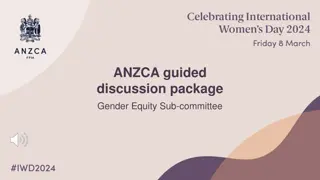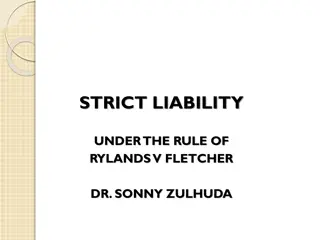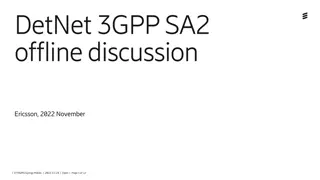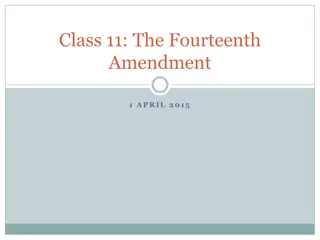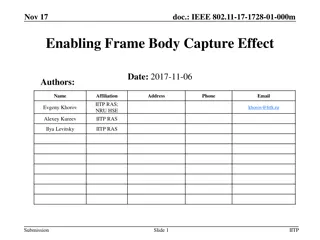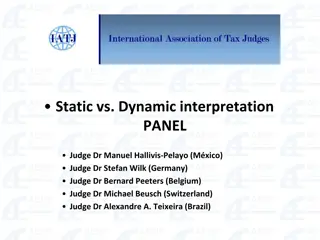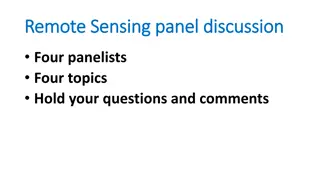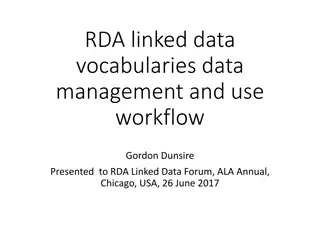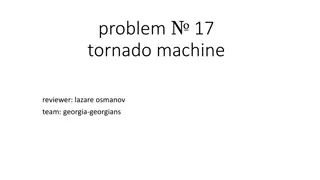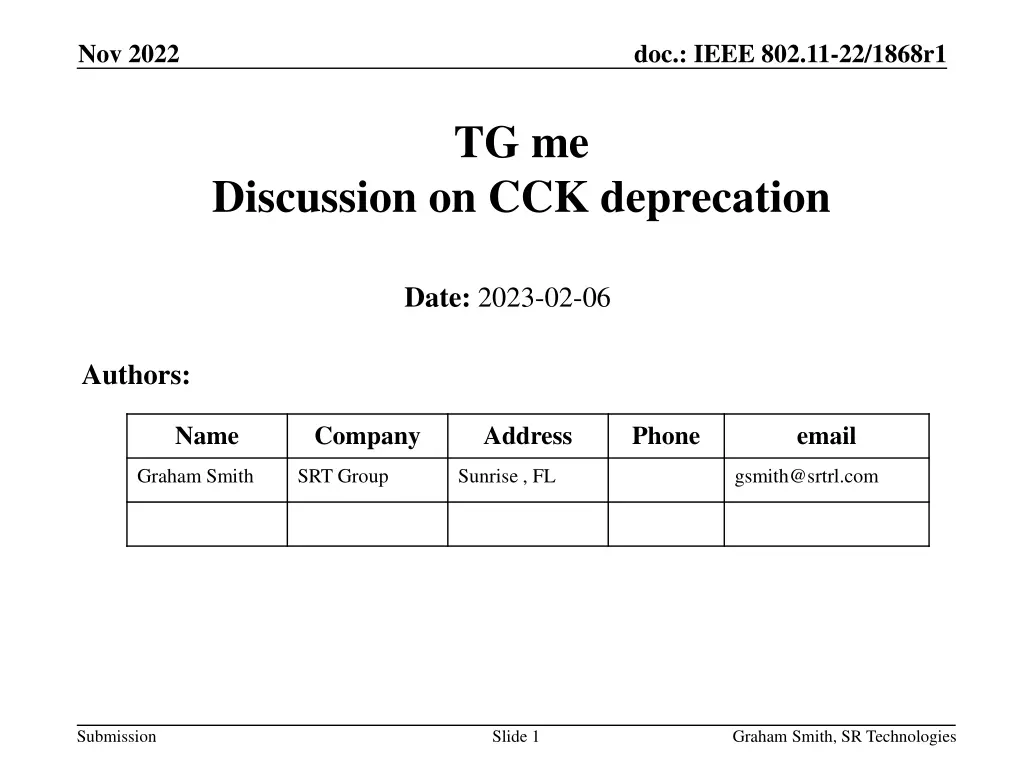
Understanding IEEE 802.11 Wireless Standards Evolution
Explore the evolution of IEEE 802.11 wireless standards from CCK to OFDM, including discussions on rate adaptation, low-rate devices, and ERP protection. Learn about the introduction of HR/DSSS and ER PHY technologies and considerations for backward compatibility.
Download Presentation

Please find below an Image/Link to download the presentation.
The content on the website is provided AS IS for your information and personal use only. It may not be sold, licensed, or shared on other websites without obtaining consent from the author. If you encounter any issues during the download, it is possible that the publisher has removed the file from their server.
You are allowed to download the files provided on this website for personal or commercial use, subject to the condition that they are used lawfully. All files are the property of their respective owners.
The content on the website is provided AS IS for your information and personal use only. It may not be sold, licensed, or shared on other websites without obtaining consent from the author.
E N D
Presentation Transcript
Nov 2022 doc.: IEEE 802.11-22/1868r1 TG me Discussion on CCK deprecation Date: 2023-02-06 Authors: Name Company Address Phone email Graham Smith SRT Group Sunrise , FL gsmith@srtrl.com Submission Slide 1 Graham Smith, SR Technologies
Nov 2022 doc.: IEEE 802.11-22/1868r1 Introduction Clause 16 HR/DSSS (11b) 5.5 and 11Mbs using CCK introduced in 1999 entered Standard 2001 Clause 18 ER PHY (ERP - 11g) Entered Standard in 2003 6, 12, 18, 24, 36 and 54 Mbps Both are backward compatible with Clause 15 DSSS Submission Slide 2 Graham Smith, SR Technologies
Nov 2022 doc.: IEEE 802.11-22/1868r1 Compare RX sensitivities* OFDM 802.11g mode at 12 Mbps OFDM 802.11g mode at 6 Mbps CCK 802.11b mode at 11 Mbps CCK 802.11b mode at 5.5 Mbps typically -90 dBm typically -93 dBm typically -89 dBm typically -90 dBm TX Power* (North America and Australia): 802.11b mode for 1 - 11 Mbps 802.11g mode for 6 - 54 Mbps Note: 6 and 12 Mbps could be higher as EVM requirement is much less than 54 Mbps typically 23 dBm typically 20 dBm Basically similar RF performance Not looking at interference or multipath where OFDM is possibly better. CCK is prone to narrowband interference * https://kb.netgear.com/1006/RF-transmit-power-and-receive-sensitivity-data-for-the-FWG114Pv2 Submission Slide 3 Graham Smith, SR Technologies
Nov 2022 doc.: IEEE 802.11-22/1868r1 Rate adaptation Rate Fall back (1) Rate Fall back (2) 24, 12, 6, 2, 1 Mbps 24, 11, 5.5, 2, 1 Mbps Why use (2)? Interested to know what is common practice Begs the questions When is 5.5 or 11 Mbps used? Would we miss them? Do we need a CCK modem in addition to the DSSS and OFDM? Submission Slide 4 Graham Smith, SR Technologies
Nov 2022 doc.: IEEE 802.11-22/1868r1 What about low-rate devices? 11b only devices? Need DSSS and CCK? What if DSSS and ERP (i.e., OFDM 6, 12 only)? 6 and 12 Mbps OFDM can use same high TX power as 1, 2Mbps OFDM has good interference and multipath protection Submission Slide 5 Graham Smith, SR Technologies
Nov 2022 doc.: IEEE 802.11-22/1868r1 Low-Rate devices (11b only) What about ERP protection? Use Protection bit in ERP IE ERP-DSSS (does not need protection) Begins with an 802.11b compatible header ERP-OFDM protection Precedes packets with CTS-to-Self (at 2 Mbps). BUT If DSSS/OFDM device, then the OFDM preamble is understood. No real need for ERP protection If 11b ONLY devices still around (in the short term), then could still set the Use Protection bit in ERP IE Submission Slide 6 Graham Smith, SR Technologies
Nov 2022 doc.: IEEE 802.11-22/1868r1 11g mandatory support for 5.5 and 11 Mb/s Clause 18.1.2 The ERP draws from Clause 17 (Orthogonal frequency division multiplexing (OFDM) PHY specification) to provide additional payload data rates of 6, 9, 12, 18, 24, 36, 48, and 54 Mb/s. Of these rates, transmission and reception capability for 1, 2, 5.5, 6, 11, 12, and 24 Mb/s data rates is mandatory. So, any device supporting the 2.4 GHz band must have a CCK modem Submission Slide 7 Graham Smith, SR Technologies
Nov 2022 doc.: IEEE 802.11-22/1868r1 So, what if we set Clause 16 to Deprecated ? Without doubt, standard chip sets better off as no need to include CCK modem. Even with no CCK modem, a legacy device transmitting CCK is understood and protected because of the DSSS preamble. Gives time for any 11b-only IoT chip vendors to replace CCK modem with the OFDM modem. BTW, this improves performances as no need for Set Protection , or ERP-DSSS or CTS-to-self. Submission Slide 8 Graham Smith, SR Technologies
Nov 2022 doc.: IEEE 802.11-22/1868r1 Deprecating CCK Steps Proposed action is: 2024 TGme make CCK deprecated BUT Keep support mandatory with a NOTE: Mandatory support for 5.5 and 11 Mb/s data rates might be removed in the next released Standard 2028 TGmf makes CCK Obsolete AND Mandatory support for 5.5 and 11 Mb/s is removed 2032 TGmg Clause 16 removed Submission Slide 9 Graham Smith, SR Technologies
Nov 2022 doc.: IEEE 802.11-22/1868r1 Actions Question on the General Reflector produced only 3 responses all erring on the conservative side. No responses that implied this feature is essential for our product(s) and market Maybe a reach out to Wi-Fi Alliance to get a marketing view? Bottom Line: Is CCK essential? NO 10 years is surely long enough notice to get rid of it? Submission Slide 10 Graham Smith, SR Technologies





